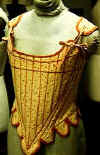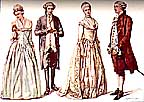|
Eighteenth
Century
Introduction
Dress in the eighteenth century France achieved an extraordinary and substained
elegance. Thanks to the political,
social, economic and cultural climate of the country, it became the inspiration
for dress in the other countries of Western Europe.
France was a monarchy and was ruled under King Louis XV.
Women began female dominance of the court and contributed to the
sophisticated development of the arts of fashion.
Two women especially held the scepter of fashion who are Madame de
Pompadour, the mistress of Louis XV and Queen Marie- Antoinettee, the consort of
Louis XVI. The influence of both
women owed its strength to the fact that women in the eighteenth century, though
having obtained no legal rights, occupied a major position in society.
Women are " the governing principle, the guiding reason, the
commanding voice."
One of the first moves of the new regime was to leave the gloomy old court at
Versailles and to establish the new center of power in Paris, home of society,
where the salon were beginning to disseminate new artistic ideas.
The
Regency style, the faerunner of the rococo, was characterized by a sense of
lightness and a playful exoticism seen in art, interior design and textiles, all
of which reacted against the measured classicism and conformity of the pervious
reign. Light colours and floating
silk with a growing vogue for the informality of the negligee, were typical of
womenís dress in the early eighteenth century; indolence and sesuality were
the keynotes of the new dispensation. Yet fashion changes do not occur overnight, and side by side
with these new fashion influences went a continuity of the old order with regard
to formal dress and particularly for menís dress, where a kind of baroque
heaviness in style and fabric continued well into the eighteenth century.
Dress for Women
French ladies began
to adopt a hoped petticoat that has already been in use in England for several
years: they passed a hoop through the lower edge of their underskirts to keep
the fabric away from their legs. This
is called the panier which resembles a cage and composed of hoops made from
plainted cord, small strips of metal or osier or rings of whalebone attached
together by ribbons. Five years
later, the panier was superseded by a petticoat made of gummed cotton or taffeta
with about five hoops threaded through it.
The hoop at the top was called the truquenand.
Small panniers with horse hair, were known as " "considerations". In the eighteenth century, the panier became the most
important item in French fashion.
 
The panier was not, however, solely responsible for moulding the female
silhoutte. The whaleboned bodice
consisted of a very rigid bodice reinforced in front by a long steel strip
whioch narrowed the waist, raised the bust and forced the shoulders back.
It explains the stiff posture of the women shown seated in paintings,
unable to bend from the waist. When
laced up in the front, this boned bodice was called "open" and when
laced up at the back, this boned bodice is called "closed".
Pregnant women were permitted laces on the sides as well.
Below are the patterns for whaleboned bodices.
The panier was quite
discreet and small in size, simply a truncated cone measuring less than 2 ells
(2m 40cm) in circumference at the hem and had the effect of flaring the dress
slightly. The robe volante or flowing gown gave freedom and movement to
the new fashion. It is not the
style of the gown that was new, but the use to which it was put. Worn over the boned bodice and the petticoat, it had
previously worn only informally, in the privacy of the boudoir (bedroom).
In fact, the appearance of scores of such robes negliges in the streets
shocked the older generation, who were accustomed to the
stricter dress codes of Louis XIV.
The gown fell slightly obliquely from the shoulders to the ground and was lifted
in front by the hand, gracefully revealing the petticoat.
The back was gathered or pleated across the shoulders to give fullness,
the sleeves were pleated along their length, terminating below the elbow with a
slightly flared cuff that revealed a sleeve of fine linen or lace. The
gown perfectly expressed the spirit of the age, with its dreams of liberty and
fluidity. Below is the picure of a
flowing gown featured by Wattena at the center of his painting Lí Enseigne de
Gersaint.
From 1725, the panier began to increase considerably in size, ultimately
adopting the shape of a huge dome which would measure
as much as 3 ells (3m 60cm) around the base.
In fact, its size was beginning to cause trouble at court.
The Church, too, was disturbed by the fashion. Despite this, more and more women succumbed to the temptation
of the panier. Even servants were
also going to the markets in panniers! Another
type of bodice was also in use at this time.
This consisted of a fitted jacket with a short basque and straight,
elbow-length sleeves with large cuffs, completed by a stomacher worn over the
chest and stomach. Below is an
example of a fitted cusaquin with sleeve cuffs to be worn over with a stomacher
and a long skirt.
In 1740, the panier became oval in shape and the robe volante changed radically,
becoming fitted over the bust thanks to a course-cloth bodice lining that laced
behind, below the pleats; the pleated back thus became a false cape reaching
from the shoulders to the hem of the skirt and merging with the skirt at ankle
level. The front of the gown was open ar the top to show the corset
or a triangular stomacher that covered the corset.
From the waist down, the gown opened to reveal a matching underskirt or
petticoat. The sleeves stopped
short at the elbow and terminated in a flared cuff, en raquette, that extended
their length; below the cuffs a pair of engageuates were worn.
In 1750, the panier divided into two boned cages fastened together with cords or
tape. These two cages were very
pronounced over the hips and became known as "elbow panniers" because
the fore-arms could be rested on them. The
robe a la francaise was decorated around the front edges of the over-dress with
puffs or with pleated bands stiched on in straight or wavy lines.
The robe a lí anglaise was worn over circular hoops and was gathered at
the back. This style of dress, in contrast to the robe a la francaise,
showed a leaning towards simplicity and a desire to free the waistline.
 
From 1770 to 1781, the robe a la francaise continued to be worn but with a
shorter petticoat and an undergown fastened at the neck rather than at the
waist. The robe a la polonaise
first appeared in 1775, consisted of a circular petticoat with a flounce round
the hem, which reached to just above the ankle and the dress cut like a waisted
coat, fastened to the bodice in front and revealing the lower point of a small
bodice below. The success of this
type of gown was due partly to the fact that it was worn over a bustle which was
less constricting than a series of hoops and accentuated the hollow of the back.
Below is a picture of both
gowns.
At the end of the eighteenth century, the taste for simplicity and comfort was
becoming more pronounced. Paniers disappeared completely and also the robe a la
francaise. Instead the robe a lí
anglaise reappeared, slightly altered, with curved whalebone hoops at the waist.
A large fichu adorned the shoulders, sometimes crossing over the chest
and tying behind. The sleeves fitted the forearm tightly and small sleevelets
of linen or lace were worn underneath. In
1790s, the circumference of gowns grew smaller. The waist was marked by a very broad belt that reached breast
height. The breasts were hidden
behind a curtain of fabric gathered on to a cord above and below.
One particular fabric was increasingly fashionable - cotton muslin used
to make single, straight gowns with long gathered sleeves and a wide ribbon
around the waist. Muslin was also used to make caracos and skirts.. Soon muslin
dresses were made without hoops and the waist below the bust which marked a new
style of classical inspiration.

|